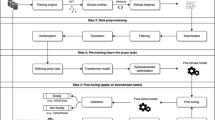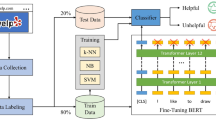Abstract
As bugs become prevalent in software development, bug triaging has become one of the most important activities in software maintenance. To decrease the time cost in manual work, text classification techniques have been applied in automatic bug triaging. In this paper, we present a new automatic bug triaging approach which is based on convolution neural network (CNN) and developer activities. Firstly, we implement the word vector representation of the text features in bug report by using Word2vec. Then, we combine CNN with batch normalization, pooling and full connection approach to learn from the word vector representation of bug report with known fixers. In addition, we also study the recent activities of the developers which can effectively distinguish similar bug reports and get a more suitable developer recommendation list. We empirically investigate the accuracy of automatic bug triaging on three large open source projects, namely Eclipse, Mozilla and NetBeans. The experimental results show that our approach can effectively improve the performance of automatic bug triaging.





Similar content being viewed by others
References
Hochreiter S, Schmidhuber J (1997) Long short-term memory. Neural Comput 9(8):1735–1780
Jeong G, Kim S, Zimmermann T (2009) Improving bug triage with bug tossing graphs. In: ESEC/SIGSOFT FSE 2009, pp 111–120
Chen R, Guo S, Wang X, Zhang T (2019) Fusion of multi-RSMOTE with fuzzy integral to classify bug reports with an imbalanced severity distribution. IEEE Trans Fuzzy Syst 27(12):2406–2420
Bugzilla, https://www.bugzilla.org/. Accessed 7, 2019
JIRA, https://www.atlassian.com/software/jira/. Accessed 7, 2019
Xi S (2018) DeepTriage: a bug report dispatching method based on cyclic neural network. J Softw 29(8):2322–2335
Anvik J, Hiew L, Murphy GC (2006) Who should fix this bug? In: ICSE 2006, pp 361–370
Xuan J, Jiang H, Yan H, Ren Z, Zou W, Luo Z, Xindong W (2015) Towards effective bug triage with software data reduction techniques. IEEE Trans Knowl Data Eng 27(1):264–280
Bhattacharya P, Neamtiu I (2010) Fine-grained incremental learning and multi-feature tossing graphs to improve bug triaging. In: ICSM, pp 1–10
Tamrawi A, Nguyen TT, Al-Kofahi JM, Nguyen TN (2011) Fuzzy set and cache-based approach for bug triaging. In: SIGSOFT FSE 2011, pp 365–375
Cubranic D, Murphy GC (2004) Automatic bug triage using text categorization. In: SEKE 2004, pp 92–97
Xia X, Lo D, Ding Y, Al-Kofahi JM, Nguyen TN, Wang X (2017) Improving Automated Bug Triaging with Specialized Topic Model. IEEE Trans Softw Eng 43(3):272–297
Somasundaram K, Murphy GC (2012) Automatic categorization of bug reports using latent Dirichlet allocation. In: ISEC 2012, pp 125–130
Deng W, Zhao H, Zou L, Li G, Yang X, Daqing W (2017) A novel collaborative optimization algorithm in solving complex optimization problems. Soft Comput 21(15):4387–4398
Guo S, Chen R, Wei M, Li H, Liu Y (2018) Ensemble data reduction techniques and multi-RSMOTE via fuzzy integral for bug report classification. IEEE Access 6:45934–45950
Zhao H, Zheng J, Junjie X, Deng W (2019) Fault diagnosis method based on principal component analysis and broad learning system. IEEE Access 7:99263–99272
Yang G, Zhang T, Lee B (2014) Towards semi-automatic bug triage and severity prediction based on topic model and multi-feature of bug reports. In: COMPSAC 2014, pp 97–106
Guo S, Chen R, Li H, Zhang T, Liu Y (2019) Identify severity bug report with distribution imbalance by CR-SMOTE and ELM. Int J Softw Eng Knowl Eng 29(2):139–175
Johnson R, Zhang T (2016) Supervised and semi-supervised text categorization using LSTM for region embeddings. In: ICML 2016, pp 526–534
Kim Y (2014) Convolutional neural networks for sentence classification. In: EMNLP 2014, pp 1746–1751
Eclipse bug database. https://bugs.eclipse.org/bugs/. Accessed 7, 2019
Mozilla bug database. https://bugzilla.mozilla.org/. Accessed 7, 2019
Netbeans bug database. https://netbeans.org/bugzilla/. Accessed 7, 2019
Deng W, Junjie X, Zhao H (2019) An improved ant colony optimization algorithm based on hybrid strategies for scheduling problem. IEEE Access 7:20281–20292
Guo S, Liu Y, Chen R, Sun X, Wang X (2019) Using an improved SMOTE algorithm to deal imbalanced activity classes in smart home. Neural Processing Letters. https://doi.org/10.1007/s11063-018-9940-3
Naguib H, Narayan N, Brügge B, Helal D (2013) Bug report assignee recommendation using activity profiles. In: MSR 2013, pp 22–30
Wu W, Zhang W, Yang Y, Wang Q (2011) DREX: developer recommendation with K-nearest-neighbor search and expertise ranking. In: Asia Pacific software engineering conference, APSEC 2011, pp 389–396
Xie Z, Zhang W, Yang Y, Wang Q (2012) DRETOM: developer recommendation based on topic models for bug resolution. In: PROMISE 2012, pp 19–28
Xuan J, Jiang H, Ren Z, Yan J, Luo Z (2017) Automatic bug triage using semi-supervised text classification. CoRR abs/1704.04769
Xuan J, Jiang H, Ren Z, Zou W (2012) Developer prioritization in bug repositories. In: ICSE 2012, pp 25–35
Deng W, Zhao H, Yang X, Xiong J, Sun M, Li B (2017) Study on an improved adaptive PSO algorithm for solving multi-objective gate assignment. Appl Soft Comput 59:288–302
Lamkanfi A, Demeyer S, Soetens QD, Verdonck T (2011) Comparing mining algorithms for predicting the severity of a reported bug. In: CSMR 2011, pp 249–258
Porter MF (2006) An algorithm for suffix stripping. Program 40(3):211–218
Zhang T, Chen J, Yang G, Lee B, Luo X (2016) Towards more accurate severity prediction and fixer recommendation of software bugs. J Syst Softw 117:166–184
Weka. https://www.cs.waikato.ac.nz/ml/weka. Accessed 8, 2019
Jia C, Yu-Qi Z, Peng S, Yan-Tao W, Wang Yu (2019) Application of deep learning to 3D object reconstruction from a single image. Acta Autom Sin 45(4):657–668
Acknowledgements
This work is supported by the National Natural Science Foundation of China (Nos. 61902050, 61672122, 61602077, 61771087, 51879027, 51579024, 71831002), Program for Innovative Research Team in University of Ministry of Education of China (No. IRT 17R13), the Fundamental Research Funds for the Central Universities (Nos. 3132019355, 3132019501, 3132019502, JLU), Next-Generation Internet Innovation Project of CERNET (NGII20190627).
Author information
Authors and Affiliations
Corresponding author
Additional information
Publisher's Note
Springer Nature remains neutral with regard to jurisdictional claims in published maps and institutional affiliations.
Rights and permissions
About this article
Cite this article
Guo, S., Zhang, X., Yang, X. et al. Developer Activity Motivated Bug Triaging: Via Convolutional Neural Network. Neural Process Lett 51, 2589–2606 (2020). https://doi.org/10.1007/s11063-020-10213-y
Published:
Issue Date:
DOI: https://doi.org/10.1007/s11063-020-10213-y




